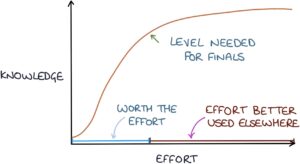The learning curve is a graph of studying vs knowledge when studying a new topic. Initially, it will be slow progress as you get your head around the basics. This will be followed by a period of rapid learning, where you understand the basics and start to fit everything else into place. This is followed by a plateau where you become competent and have sufficient knowledge, and you are only learning the extra little details which may represent only a tiny fraction of the exam.
The key to the most efficient way to learn medicine is to spend as much of your study time as possible in the rapid learning phase. Each topic area (e.g. respiratory medicine) will have a learning curve. When you’re learning starts to plateau on a given topic area, your efficiency at gaining knowledge with the study effort will drop. At this point, it is far more efficient to move on to another topic area and start learning that topic faster. This way you stay challenged, motivated, efficient and effective. Of course, when you have reached a satisfactory level of knowledge for all the topics for the exam you are sitting, you can go back and learn the small print.

Ultimately medicine is so huge that you can spend a lifetime learning only one topic. The aim of medical school is to learn medicine as broadly as possible. By moving on when you plateau in your learning curve and staying on the steepest part of the curve at all times, you will maximise your efficiency at reaching the ultimate goal of a broad knowledge base.
